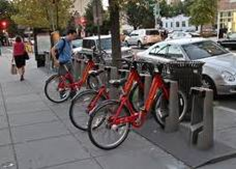Washington, DC Has New, Hot Bike Share Program
by Melanie D.G. Kaplan, SMART PLANET, November 15, 2010
 Two blocks from my rowhouse in one direction, and four blocks in the other direction, are solar-powered stations filled with brand new, red, three-speed bikes with flashing LED lights. They seemed to appear overnight, and everyone in Washington seems to be talking about them. I’m smitten.
Two blocks from my rowhouse in one direction, and four blocks in the other direction, are solar-powered stations filled with brand new, red, three-speed bikes with flashing LED lights. They seemed to appear overnight, and everyone in Washington seems to be talking about them. I’m smitten.
Capital Bikeshare–or CaBi, for those in the know–rolled into town in late September and is the largest and one of the first such programs in the U.S. Rates are $5 a day or $75 for an annual membership–which includes an electronic key. The first 30 minutes of riding is free for members, and charges increase with time after that.
One of the first things the city’s Bikesharing Project Manager Chris Holben explained to me is that the system encourages users to ride short distances and get bikes back in circulation. (If you want a bike for the day, go to a rental shop.) Bike sharing is for getting from point A to point B, not so much for a recreational ride. With 100 stations in the District (and 14 in Arlington, Va.), it’s easy to find a station near your destination, whether it’s work, the barber shop or the bar.
The program falls under the District Department of Transportation, and it has created such goodwill with these bikes that we might even forgive the city’s potholes. Last week, I talked to Holben about the ins and outs of the program—including the story of how body paint ended up on one of his bikes. Excerpts of our conversation are below.
We’re almost two months into the country’s largest bike share program. What stats do you have?
It started September 20, and through November 8 we have:
- 52,000 trips, 38,000 of which were by members versus day users; and
- 4,480 annual members.
Dupont Circle has been the busiest station, followed by 14th and U streets. There’s definitely a rush hour trend during the week and more casual users on the weekend.
How do those numbers compare to what you expected?
We felt it picked up quickly, but it’s not a super big surprise. The speed of us reaching 4,480 is very successful for just a month and a half of usage. We’ve been lucky with a fairly nice fall.
There are 100 stations now. What’s the plan for expansion?
We’re looking to add about 20 more this spring and then it’s really more an issue of political will and how the budget looks. I know we’re interested in expanding.
I’ve worked for D.C. government for close to 10 years and usually things work very slow here, which is typical for big projects like roads and bridges, so being able to install this many of anything in a month is remarkable. The system is so elegant that you can put down one [station] in an hour, and you flip the switch and it’s online. You bring by a truck an hour later and deliver the bikes.
It’s surprising to me that Washington now has the country’s largest bike share program. Why is that?
There’s only two others in the States–Minneapolis and Denver.
In the European cites they’ve had it for four or five years now and have gotten lots of press. The Paris and Barcelona systems are huge compared to anything over here. People don’t quite understand it here. To really make it work you need to make a big splash at one time. You can compare it to a bus stop—you need to be able to walk to a bike station from your office or home or a Metro station. The use potential expands exponentially as you add more stations.
And it’s expensive to start up a big system like this.
How much of the cost of the program is covered by the city versus user fees, and how might this shift down the road?
Right now, the city covers all the costs. We’re recouping revenue on a monthly basis and that includes the membership fees and usage fees (if you take the bike out for more than 30 minutes).
The capital cost is about $5 million for 100 stations and the operations for 100 stations is about $2.3 million a year. So we’re hoping and expecting to cover at least 50 percent of the cost of the operations on a yearly basis through membership and usage fees. If and when D.C. is able to accept advertising or sponsorship, that percentage will go much higher.
There’s a law that prohibits advertising on District-owned property without special legislation. A special legislation was passed to allow advertising on bus shelters. It is something we’re looking into. [Read rest of story]


